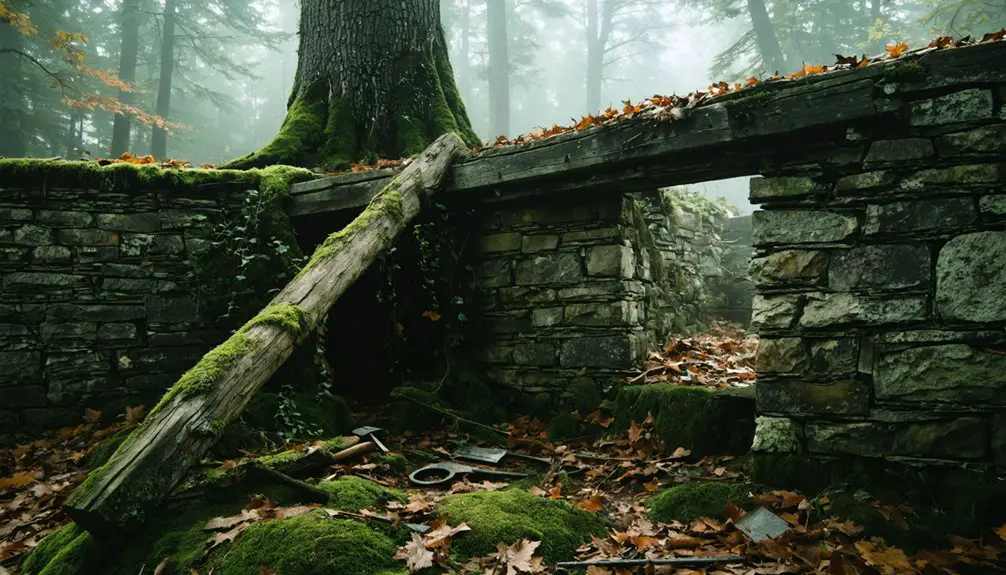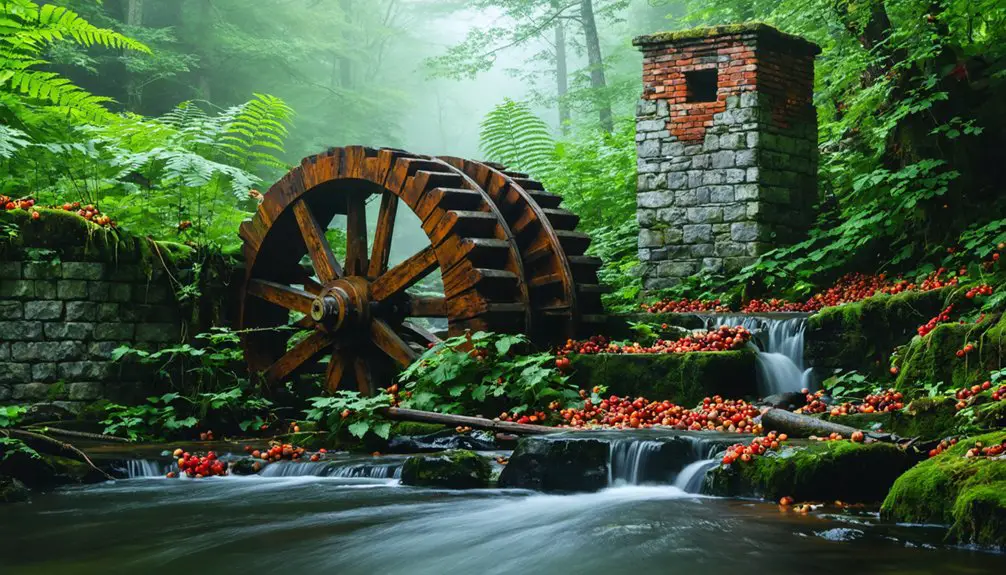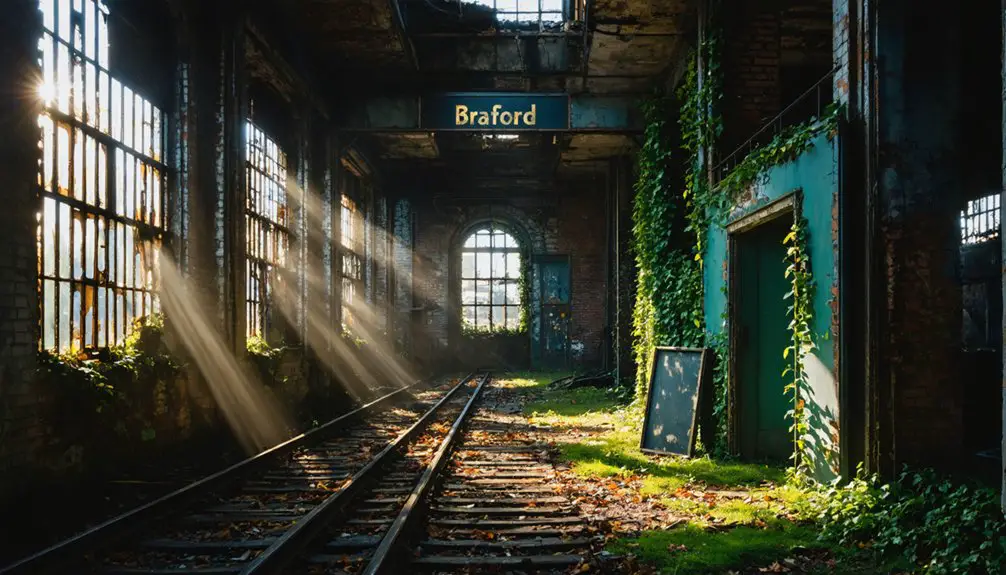You’ll find Pine Hill nestled in northern Smithfield, Rhode Island, where a colonial settlement mysteriously vanished in the early 1800s. The site features stone foundations, cellar holes, and an intact well from its 1730s heyday, when settlers thrived through farming and leather tanning. Local historians suggest the town’s gradual decline followed the death of original settlers, with the last Hanton family member passing around 1900. The area’s rich history holds more secrets beneath its abandoned stones.
Key Takeaways
- Pine Hill Cemetery, established in 1769, became known as “Blood Cemetery” due to Abel Blood’s allegedly haunted grave and supernatural occurrences.
- Hanton City, a colonial settlement near Pine Hill, was mysteriously abandoned in the early 1800s, leaving only stone foundations and wells.
- The area was originally inhabited by Narragansett tribes before European colonization led to settlements in the mid-1600s.
- Local legends include ghostly apparitions of a murdered family’s young boy who attempts to flag down passing vehicles.
- The site features architectural remnants from three distinct colonial periods, including robust stone foundations and well constructions.
The Origins of Pine Hill Cemetery (1769)
Nestled along Pine Hill Road, the cemetery’s origins trace back to Benjamin Parker Jr.’s land donation in 1769, though its history as a burial ground extends much further.
You’ll find that Native Americans used this sacred ground, known as “The Pines,” for two centuries before European settlers arrived.
The site’s official establishment as a town cemetery dates to March 29, 1731, when 1.5 acres were designated near the meetinghouse.
Early burial practices were informal, resulting in somewhat random grave placements. Cemetery symbolism evolved considerably by the 1750s, shifting from skeletal death imagery to hopeful winged cherubs representing heavenly ascent.
Cemetery art transformed from grim skeletal motifs to uplifting cherub designs, mirroring evolving beliefs about death and the afterlife.
The community viewed death not as an end but as a spiritual passage, reflected in their burial customs and gravestone art. This perspective shaped Pine Hill’s development as both a practical necessity and a sacred space. Today, the cemetery serves as the final resting place for nearly three hundred individuals whose markers tell the story of local history. The earliest gravestone at the site dates back to 1750, marking an unknown individual with the initials “J W.”
Blood Cemetery: How the Name Came to Be
While Pine Hill Cemetery‘s early history centers on Benjamin Parker Jr.’s land donation, its modern identity stems from a single grave that’s sparked decades of local folklore.
The cemetery’s popular nickname, “Blood Cemetery,” comes from Abel Blood, whose 1867 burial site became infamous for its distinctive gravestone featuring a carved finger that locals swear pointed upward during daylight and downward at night.
You’ll find that ghostly encounters at the site often center around Blood’s grave, though vandals have since destroyed the famous marker. Police monitoring has been increased at the cemetery due to the vandalism issues.
While officially known as Pine Hill Cemetery or Elder Ballou Meeting House Cemetery, the “Blood” moniker stuck purely due to Abel’s supernatural reputation – not from any actual bloodshed.
The name perfectly captures the eerie atmosphere that’s made this location a magnet for cemetery myths and paranormal investigators. Local legends about Abel Blood’s spirit haunting the grounds persist, though historical records show no evidence of the family murder stories often associated with the site.
Local Legends and Haunting Tales
Throughout Pine Hill’s storied past, one haunting tale has persisted above all others – the ghostly apparition of a young boy who materializes along Pine Hill Road, desperately trying to flag down passing vehicles before vanishing into thin air.
The boy’s spirit, along with those of his murdered family from the 1800s, is said to roam the grounds of Pine Hill Cemetery, where they were laid to rest. Many visitors have reported experiencing strange cold spots and unexplained voices, similar to other historic graveyards.
The site’s dark history extends beyond the cemetery walls to Hanton City’s abandoned ruins, where spectral encounters are frequently reported near an old well and crumbling cellar holes.
These desolate structures, mere shadows of a once-thriving settlement, serve as silent witnesses to centuries of unexplained phenomena that continue to draw paranormal enthusiasts and fearless explorers to this haunted corner of Rhode Island.
The site’s historical importance dates back to when three English families received land grants following King Philip’s War, marking the beginning of European settlement in the area.
The Mysterious Abandonment of Hanton City
Deep in the woods of what’s now northern Smithfield, Rhode Island, lies the abandoned settlement of Hanton City, which mysteriously emptied in the early 1800s.
You’ll find stone foundations, cellar holes with steps, and an intact well – silent witnesses to the settlement’s puzzling demise. The remnants of an old stone wall still stand as evidence of the former community.
The community once thrived as residents engaged in farming and leather tanning during its peak in the 1730s.
Several theories attempt to explain Hanton City’s abandonment. Some believe the settlers were Loyalists who faced exile during the American Revolution, while others suggest the site housed isolated disease victims.
Local historian Jim Ignasher points to a simpler explanation: the original English families – the Paines, Hantons, and Shippees – likely received the land for service in King Philip’s War, and the settlement naturally dwindled as descendants died out, with the last Hanton passing around 1900.
Colonial History and Indigenous Connections
Pine Hill’s earliest European settlements emerged within lands traditionally inhabited by the Narragansett people, who’d established seasonal camps and left evidence through shell middens and stone tools.
The area’s colonial development began in the mid-1600s through land transactions with Native Americans, following Roger Williams’ model of fair dealings and religious tolerance. By 1642, many of the indigenous people had already fallen victim to European diseases.
Before European contact, an estimated 144,000 Native Americans lived throughout the Narragansett Bay region, maintaining a rich cultural and economic presence.
Trading relationships between colonists and the Narragansett initially flourished around Pine Hill’s valuable coastal resources, though these partnerships would later dissolve during the devastating King Philip’s War of 1675-1676.
Early Settlement Patterns
Settlement patterns in Pine Hill emerged from pivotal land grants in the mid-1600s, when colonial proprietors like John Mowry and Edward Inman received substantial parcels combining uplands, swamps, and meadows.
You’ll find that early settlement concentrated around Sayles Hill, where sturdy timber-framed houses with stone chimneys marked permanent colonial footholds.
The Great Road, connecting Providence to Worcester, became the lifeline of Pine Hill’s growth.
Along this route, you’d have seen an agrarian economy develop as settlers cleared land for mixed-use farming. They built stone-end houses using local materials, especially after King Philip’s War in 1675-76.
Trading networks flourished along the Great Road, while proximity to the Woonasquatucket River influenced where colonists chose to establish their farms and homesteads.
Native Lands and Disputes
Before colonial settlers arrived, the lands of Pine Hill belonged to Algonquian-speaking peoples, primarily the Narragansett and Niantic tribes, who maintained deep spiritual and cultural connections to the area.
You’ll find evidence of their presence in sacred sites like the Green Hill Mound, where burial artifacts reveal complex ritual practices dating to the Mississippian period.
The struggle for Indigenous sovereignty intensified during colonization, as European settlers systematically displaced Native communities through warfare, broken treaties, and legal manipulation.
King Philip’s War (1675-1676) proved especially devastating for local tribes.
Today, Native communities continue fighting for land restitution and site preservation, particularly around ceremonial grounds and burial mounds threatened by erosion and development.
The Pine Hill Indian Tribe actively works to protect these sacred spaces, viewing them as vital links to their ancestral heritage.
Colonial-Indigenous Trading Relations
Despite the violent conflicts that marked colonial expansion, trade relations between Indigenous peoples and settlers formed complex economic networks throughout Pine Hill and wider Rhode Island.
The trade dynamics between these groups created lasting economic partnerships, where Indigenous peoples supplied valuable furs, skins, and local resources in exchange for European manufactured goods.
You’ll find evidence of these cultural exchange patterns in:
- The granite quarries near Pine Hill, where Indigenous knowledge of local stone deposits influenced colonial building practices
- Trading posts where settlers bartered oriental goods like Chinese tea for Native American products
- The network of roads and trading routes that connected Indigenous communities to colonial markets
This interdependent commerce fostered communication between cultures and shaped Pine Hill’s development as a significant trading hub in colonial Rhode Island.
The Granite Quarry Legacy
Along Pine Hill’s rugged terrain in Graniteville, Johnston, a thriving granite quarrying operation emerged in the early 19th century, leaving an indelible mark on Rhode Island’s architectural heritage.
You’ll find evidence of both pit quarrying techniques and surface extraction methods that shaped the landscape around the prominent Bare Rock Ledge.
The quarry’s crowning achievement came in 1826 with The Arcade’s massive columns in Providence.
You can imagine the scene: up to 18 pairs of oxen hauling these architectural giants over eight miles of dirt roads on custom-built wagons. They’d reinforce bridges just to handle the weight.
While one column met its fate during transport and now marks a grave in North Burial Ground, the remaining columns stand as evidence of the quarrymen’s skill and determination.
Notable Architectural Contributions
Pine Hill’s architectural legacy reveals itself through three distinct periods of colonial settlement, with surviving foundations and structural remnants telling a rich story of 17th and 18th-century building practices. The historical architecture reflects practical colonial influences, featuring substantial stone foundations beneath kitchens and robust well constructions that have withstood centuries.
- Large central brick chimneys dominated the two-and-a-half story farmhouses, as seen in the surviving Martin Smith Farm and Battey-Barden House.
- Stone masonry techniques produced enduring cellar walls and steps that you can still trace today.
- Agricultural structures like corn cribs sat atop innovative stone platforms, preventing crop loss from ground moisture.
These architectural elements showcase the resourcefulness of early settlers who balanced utility with durability, creating structures that defined Pine Hill’s colonial character.
Paranormal Activity and Reported Sightings
Beyond the architectural remnants of Pine Hill’s colonial past lies a rich tapestry of paranormal activity that has captured the attention of ghost hunters and historians alike.
You’ll encounter spectral evidence throughout the area, from the mysterious apparition of Mr. Abel Blood in the cemetery to the Lady in White who startles drivers on lonely roads.
The most compelling ghostly encounters occur near the Sprague Mansion, where Amasa Sprague and little Theodora’s spirits roam, while unmarked graves echo with children’s voices.
Physical manifestations include unexplained scratches on visitors’ skin, moving objects, and cold spots that defy explanation.
Strange marks appear on visitors, objects shift mysteriously, and icy patches materialize without reason in Pine Hill’s haunted spaces.
Multiple investigations have documented these phenomena through thermal imaging and audio recordings, while local property owners report fluctuating paranormal activity linked to human occupation.
Preserving Pine Hill’s Historical Significance
You’ll find Pine Hill’s rich history preserved through meticulous documentation efforts, including the 1937 Providence Journal articles and cemetery registries that track the site’s founding families and settlement patterns.
Local historical societies actively maintain these essential records while coordinating with universities to conduct archaeological research and documentation of remaining stone foundations, wells, and cellar holes.
Community-driven restoration projects focus on stabilizing physical structures, cataloging gravestones, and creating educational programs that connect visitors to the ghost town’s historical narrative.
Historical Documentation Methods
Through meticulous documentation efforts spanning several centuries, historians have preserved Pine Hill’s rich historical legacy using multiple complementary methods. Archival techniques include land deed research, genealogical records, and Providence Journal articles that trace ownership and settlement patterns. Oral tradition, passed down through generations, provides invaluable context for understanding the area’s cultural significance.
- Detailed survey maps outline historic roadways and town boundaries, offering insight into Pine Hill’s connection to major colonial routes.
- Photographic documentation captures the evolution of quarry landscapes, stone foundations, and Victorian cottage restorations.
- Archaeological surveys map cellar holes, wells, and cemetery plots using modern GPS and drone technology.
Together, these methods create an extensive record of Pine Hill’s transformation from colonial settlement to ghost town.
Community Restoration Initiatives
Since Pine Hill’s decline in the early 20th century, dedicated preservation groups have launched extensive initiatives to protect this historic ghost town‘s remaining structures and artifacts. Through targeted preservation techniques, you’ll find stabilized stone foundations, cellar steps, and wells that maintain the site’s historical footprint despite centuries of decay.
Community involvement stands at the heart of Pine Hill’s restoration. You can join local historians and volunteers in archaeological mapping projects, help document artifacts, or participate in public excavation programs.
These hands-on efforts have uncovered essential features while fostering a sense of stewardship among residents. The findings support educational exhibits, heritage tourism, and school partnerships that bring Pine Hill’s story to life through informational signage, guided tours, and innovative multimedia presentations.
Frequently Asked Questions
Are There Any Remaining Descendants of Pine Hill’s Original Settlers Still Living Nearby?
You won’t find documented descendant lineage of original settlers in the immediate area today, though some families with local heritage may exist in broader regional towns without verified connections.
What Safety Precautions Should Visitors Take When Exploring the Abandoned Quarry Sites?
Like moths to a flame, you’re drawn to explore – but don’t venture alone. Wear proper safety gear including respirators and boots, stay clear of unstable ground, and tell someone your plans.
How Many Documented Deaths Occurred in the Pine Hill Area Before Abandonment?
You’ll find historical records indicate around 300 documented deaths through cemetery records, though local legends suggest more. The area’s historical significance includes settler conflicts and family tragedies before abandonment.
Has Any Professional Paranormal Research Team Conducted Official Investigations at Pine Hill?
While you might hear stories of ghostly encounters, there’s no confirmed record of professional paranormal investigations or official ghost sightings at Pine Hill. Local paranormal teams typically focus on other Rhode Island locations instead.
Where Are the Original Town Records and Documents From Hanton City Stored?
You won’t find direct Hanton City records in one location, but you’ll likely discover scattered documents in Smithfield’s town archives, Rhode Island State Archives, and local historical preservation societies that maintain colonial-era materials.
References
- https://www.ghostsofnewengland.com/blood-cemetery-pine-hill-cemetery/
- https://www.youtube.com/watch?v=kpy7zlXYrAU
- https://undeadauthorsociety.wordpress.com/2019/10/23/rhode-island-ghosts/
- https://johnstonsunrise.net/stories/the-quarries-on-pine-hill
- https://www.tiktok.com/@ghoulplease_/video/7404223320260005166
- https://www.dover.nh.gov/government/city-operations/library/research-learn/Heritage-Walking-Tours/2004-heritage-walking-tour/
- https://goodspeedhistories.com/pine-hill-cemetery-revisited/
- http://www.mountolivethistory.com/stories-in-stone-blog/previous/4
- http://rihistoriccemeteries.org/newsearchcemeterydetail.aspx?ceme_no=RD027
- https://sentinelhillpress.com/2015/10/15/october-ganza-day-15-new-englands-haunted-cemeteries-part-2/



